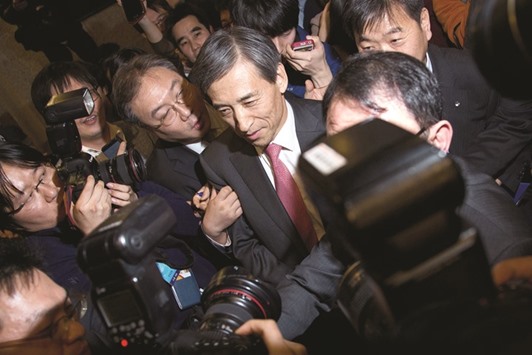South Korea’s central bank surprised markets by cutting interest rates to a record low 1.25% yesterday, to cushion the economy against weak exports and the fallout from a massive restructuring of an ailing shipping industry.
The 25 basis points reduction was the first cut since the Bank of Korea (BoK) last lowered rates in June 2015.
Though low inflation is a source of concern, and a reason for lowering interest rates, some economists doubted whether the central bank could afford to cut again once an anticipated increase in US interest rates finally takes place.
Just four of 23 analysts surveyed by Reuters had forecast the central bank would lower the rate, although most of those who saw a June hold forecast that rates would be cut in July.
The decision to cut rates was unanimous, governor Lee Ju-yeol told a news conference.
“The problem is in the second half of the year, when we see downside risks increasing,” said Lee.”We feel the sluggishness in global trade is worse than we expected.
And there will also be downside risks once corporate restructuring begins in earnest.”
The move came just a day after the International Monetary Fund said South Korea needed to speedily implement additional fiscal stimulus and ease monetary policy to offset risks posed by “weak and volatile external demand”.
A tumble in trade since January last year has darkened the outlook for South Korea’s export-driven economy – Asia’s fourth-largest – while persistently weak inflation opens the door to yet lower rates.
The finance ministry will be releasing their policy plans for the second half of the year later in June.
The ministry usually announces revised economic forecasts at this time and some analysts believe a supplementary budget will also be on the agenda.
On Wednesday, the government and central bank said an 11tn won ($9.50bn) fund would be created to support two state-run banks most exposed to the once-thriving shipping and shipbuilding sectors.
By the time the proposed restructuring is complete in 2018, major shipbuilders’ capacity will likely have fallen 20%, and their workforce by 30%.
“We continue to watch the interplay between progress on corporate restructuring, the likely impact this will have on domestic demand, and how other policy branches of government respond to this,” ANZ said in a note.
“Monetary easing alone is not sufficient to absorb the burden corporate restructuring places on the South Korean economy.”
At yesterday’s news conference governor Lee insisted the bank had fully signalled the rate cut at its previous meeting, noting the bank’s decisions did not hinge on the policy of the US Federal Reserve, which is expected to raise rates at least once this year.
Many analysts saw June or July as the last chance for the BoK to cut rates as the Fed rate hike looms closer.
“Many expected the US Federal Reserve to hike rates in June or July but after the May jobs data a June hike now seems impossible.
The BoK probably thought taking action before the Fed’s rate hike would be safer,” said Lee Sur-bee, a fixed-income analyst at Samsung Securities.
The analyst said Thursday’s move would be the last cut this year, a view shared by many other economists contacted by Reuters.
The BoK chief added interest rates at home should remain higher than those of advanced economies.
Bond futures erased some gains after the BoK news conference, but were still up 0.07 points, trading at 110.63.
The won was flat against the dollar as of 0418 GMT after collapsing briefly following the rate cut. Addressing the problem of South Korea’s high household debt, the BoK chief said borrowing would likely slow, despite lower interest rates, because banks are screening borrowers more closely.
Inflation would likely approach the bank’s 2% target in 2017, he said.
The BoK is expected to trim its GDP growth forecast of 2.8% for this year at a quarterly review in July.
The IMF lowered its 2016 GDP forecast for South Korea to 2.7% from 2.9% in April while earlier this month the OECD slashed its projection from 3.1% to 2.7%.

Bank of Korea governor Lee Ju-yeol talks to the media in Seoul. South Korea’s central bank surprised markets by cutting interest rates to a record low 1.25% yesterday.


